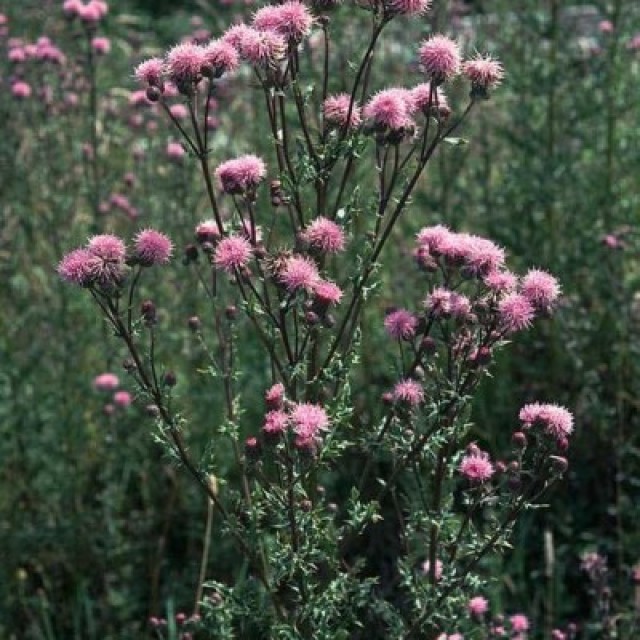COMMON NAME
creeping thistle
SCIENTIFIC NAME
Cirsium arvense
ALSO KNOWN AS
California thistle, Creeping thistle
Plant family
Aster (Asteraceae)
Plant group
Wildflowers and Herbs
Creeping thistle is herbaceous perennial plant with small purple flower heads that behaves as a noxious weed across most of North America.
124 reports
49+
OBSERVERS
124+
OBSERVATIONS
Identification hints
Creeping thistle is distinguished from other thistles by its deep running perennial rootstocks, dense clonal growth, more slender stems, spiny lobed leaves, and compact purple flower heads, 1-5 of which are on each flowering stalk.
Did you know?
Creeping thistle is originally native to Europe but has accidentally been introduced around the world. It has become one of the most aggressive weeds worldwide likely because it has a competitive advantage; it produces roots that grow deep into the earth as well as spread laterally, it tends to form dense colonies, and individual plants can produce thousands of seeds that disburse in the wind.
DISTRIBUTION IN TH U.S.
Alaska
,
Alabama
,
Arkansas
,
Arizona
,
California
,
Colorado
,
Connecticut
,
Delaware
,
Iowa
,
Idaho
,
Illinois
,
Indiana
,
Kansas
,
Kentucky
,
Massachusetts
,
Maryland
,
Maine
,
Michigan
,
Minnesota
,
Missouri
,
Montana
,
North Carolina
,
North Dakota
,
Nebraska
,
New Hampshire
,
New Jersey
,
New Mexico
,
Nevada
,
New York
,
Ohio
,
Oregon
,
Pennsylvania
,
Rhode Island
,
South Dakota
,
Tennessee
,
Utah
,
Virginia
,
Vermont
,
Washington
,
Wisconsin
,
West Virginia
,
Wyoming
HABITAT
It is found widely distributed throughout the northern US and Canada in a wide variety of habitats. Creeping thistle does best in upland disturbed areas and is found in barrens, glades, meadows, fields, pastures, and abandoned lands. It is known to invade wet and marshy meadows and can be found in rivers and streams. Creeping thistle is not fussy about soil and is found in many soil types including gravelly and clay soils and even dunes.
ATTRIBUTES
Leaves
The stems are often slightly hairy and ridged although rarely spiny. The leaves are simple, lance-shaped, with irregular lobes, spines along the toothed margins, and with wooly hair on the lower surface. They vary in size from 2 to 8 in long. The leaves are found both singularly and alternately along the stem. Leaf development generally occurs from May to June.
Flowers
One to several flower heads are located at the ends of each flowering stalk, each about 3/4 of an inch in diameter. The fragrant flowers are rose purple to lavender and sometimes white. The bracts are not spiky although the tips of the bracts appear pointy and are often purple in color. Some plants are exclusively male or female but others are actually hermaphroditic.
Fruits
The small, light brown seeds have a long tuft of feathery white hairs on the end, so that the flower heads have a ‘cottony’ appearance. The seeds are wind dispersed.
Bloom Time
Bloom times are generally from May through October but varies based on location.
See Menu
- 2021 Chicago Botanic Garden. All Rights Reserved.
-
Creative Commons
BY-NC-SA 4.0 - Terms of Use
- Privacy Policy
- Data Sharing and Citation Policies
- 2021 Chicago Botanic Garden. All Rights Reserved.



